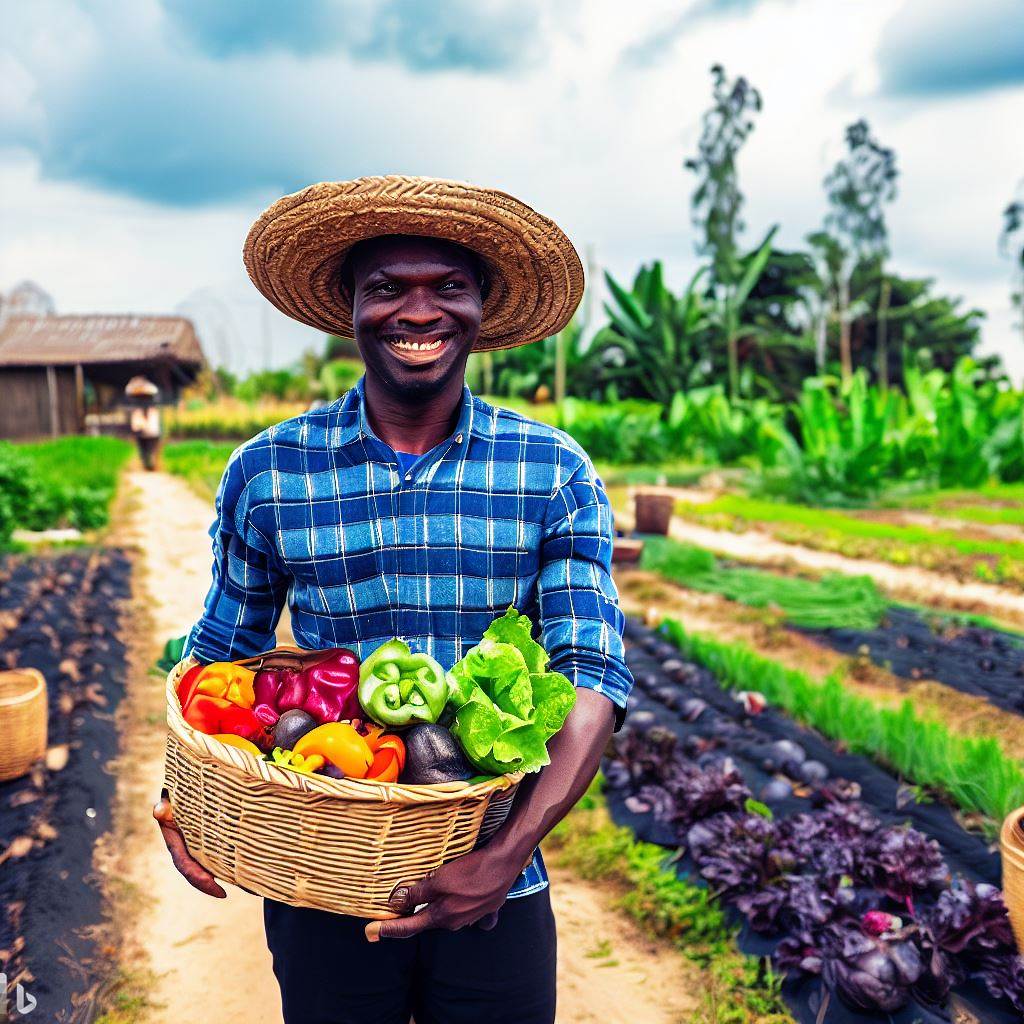Introduction
Smallholder vs. Large-scale Farming in Nigeria
In Nigeria, the comparison and evaluation of smallholder and large-scale farming hold immense significance and relevance in the agricultural context of the country.
These two farming methods play a critical role in the nation’s food production and overall economic development.
Thesis statement
This blog section aims to provide a comprehensive analysis of the advantages and disadvantages of smallholder and large-scale farming in Nigeria, focusing on their impact on productivity, income generation, environmental sustainability, and rural development.
Smallholder farming, which involves individual farmers cultivating small plots of land, remains the predominant agricultural practice in Nigeria.
It provides livelihoods to millions of rural households and contributes to food security at the local level.
However, smallholder farmers often face various challenges such as limited access to credit, inadequate infrastructure, and outdated farming techniques.
On the other hand, large-scale farming, characterized by extensive landholdings and mechanization, has gained prominence in recent years.
It offers economies of scale, advanced production technologies, and increased market competitiveness. Large-scale farms attract investments, enhance productivity, and promote commercial agriculture.
Nonetheless, this approach may have negative consequences for smallholder farmers and the environment, leading to land concentration, loss of biodiversity, and potential social disparities.
Through this blog chapter, we seek to shed light on the strengths and weaknesses of both farming models, fostering a holistic understanding among policymakers, researchers, and stakeholders.
By exploring potential synergies between smallholder and large-scale farming, Nigeria can develop sustainable agricultural practices that ensure food security, rural development, and inclusive growth for all its citizens.
Overview of Smallholder Farming
Smallholder farming in Nigeria involves cultivating crops and raising livestock on limited land with traditional methods.
Characteristics
- Low capital investment
- Subsistence-oriented production
- Family labor
- Limited access to modern technology
Smallholder farmers are crucial for food security, producing staple foods like rice, maize, and yam.
Challenges
- Limited finance and credit access
- Lack of modern equipment and technology
- Inadequate infrastructure
Despite challenges, smallholder farming empowers communities, preserves traditions, and supports rural livelihoods.
Supportive policies are needed
- Improved finance access
- Technical assistance
- Infrastructure development
- Capacity building programs
Smallholder farming ensures food security, provides livelihoods, and contributes to cultural heritage and economic growth in Nigeria.
Read: Emerging Trends and Technologies in Agricultural Operations Management
Overview of Large-scale Farming
- Definition and Explanation of Large-scale Farming: Large-scale farming refers to agricultural practices that involve extensive land, capital, equipment, and labor.
It is a highly mechanized and commercialized form of farming that aims to maximize production. - Characteristics and Features of Large-scale Farming in Nigeria: Large-scale farming in Nigeria is characterized by the use of modern technology, high input application, specialized management, and the cultivation of cash crops or livestock for commercial purposes.
- Discussion on the Contribution of Large-scale Farming to Commercial Agriculture and Economic Growth: Large-scale farming plays a significant role in commercial agriculture and economic growth in Nigeria.
It leads to increased production, higher farmer incomes, job creation, and export earnings. - Increased Production: Large-scale farming utilizes modern techniques, machinery, and inputs, leading to enhanced productivity.
This contributes to meeting domestic demand and reducing dependence on food imports. - Higher Farmer Incomes: Commercial farming generates higher incomes for farmers due to economies of scale, access to credit, and guaranteed markets.
This, in turn, improves their living standards and reduces poverty. - Job Creation: Large-scale farms require a significant labor force for various activities such as cultivation, harvest, packaging, and transportation.
Hence, they create employment opportunities, especially for rural areas. - Export Earnings: Through large-scale farming, Nigeria can export surplus agricultural produce, earning foreign exchange and strengthening its economy.
Challenges and Limitations Faced by Large-scale Farms in Nigeria
Despite its benefits, large-scale farming in Nigeria faces several challenges and limitations.
- Limited Access to Finance: Acquiring capital and loans for investment in large-scale farming is often a major challenge, particularly for smallholder farmers interested in scaling up.
- Inadequate Infrastructure: Insufficient access to reliable power supply, irrigation facilities, good roads, and storage facilities hinder large-scale farming operations.
- Inefficient Market Structure: The absence of well-structured and organized markets for agricultural produce makes it challenging for large-scale farmers to sell their products at fair prices.
- Environmental Concerns: Large-scale farming may have adverse environmental impacts, such as deforestation, soil degradation, water pollution, and the excessive use of agrochemicals.
- Land Tenure Issues: Securing suitable and contiguous land for large-scale farming is a challenge due to unclear land ownership, traditional land tenure systems, and conflicts arising from land grabbing.
Large-scale farming is a crucial component of commercial agriculture and economic growth in Nigeria.
It has the potential to boost production, increase farmer incomes, create employment opportunities, and contribute to export earnings.
However, addressing the challenges faced by large-scale farms, such as limited access to finance, inadequate infrastructure, and environmental concerns, is essential to fully harness its benefits and ensure sustainable agricultural development.
Read: Impact of Climate Change on Livestock in Nigeria
Comparison of Smallholder and Large-scale Farming
Comparison of smallholder and large-scale farming in Nigeria highlights their differences in scale, resources, and impacts.
Smallholder farming operates on a limited scale, relying on manual labor, family contributions, or hired workers.
Smallholder farms range from 1 to 5 hectares, often lacking access to essential resources and technology.
In contrast, large-scale farming covers extensive land areas, incorporating modern machinery and technology for higher productivity.
Labor requirements impact productivity and income. Smallholders depend on manual labor, leading to lower efficiency.
Large-scale farming employs machinery, enhancing productivity and income potential.
Smallholder farming preserves cultural practices, biodiversity, and community cohesion. Income circulates within local economies, fostering growth.
However, large-scale farming’s expansion poses challenges. It displaces smallholders, altering communities and traditions, impacting local economies.
Efficiency, sustainability, and profitability differ. Smallholders prioritize sustainability through organic practices and crop diversification.
Large-scale farming focuses on profitability with intensive chemical use, affecting environmental sustainability.
Balancing smallholder and large-scale farming is vital for equitable development, sustainability, and community well-being in Nigeria.
Read: Emerging Trends in Agronomy Sales in Nigeria

Advantages and Disadvantages of Smallholder Farming
Smallholder farming, also known as subsistence farming, plays a crucial role in Nigeria’s agricultural landscape.
It involves cultivating small plots of land and is primarily practiced by rural farmers. While smallholder farming offers numerous advantages, it also comes with certain limitations.
Advantages of Smallholder Farming
- Food Security: Smallholder farming contributes to food security by providing diverse food sources and reducing dependence on external sources.
- Local Economic Development: Smallholder farming stimulates local economies, creating job opportunities within rural communities.
- Income Generation: Smallholder farmers can generate income by selling surplus produce in local markets or through value-added processing.
- Preservation of Indigenous Crops: Smallholder farmers often cultivate indigenous varieties, preserving traditional knowledge and biodiversity.
- Sustainable Land Management: Smallholder farmers tend to use eco-friendly techniques, such as organic farming and crop rotation, minimizing soil degradation.
- Community Cohesion: Smallholder farming promotes social cohesion and a sense of belonging within communities, strengthening social ties.
- Adaptability: Smallholder farmers are adaptable and can quickly respond to market demands and changing climate conditions.
Disadvantages of Smallholder Farming
- Limited Access to Resources: Smallholder farmers often face challenges in accessing capital, inputs, modern technologies, and markets, limiting their productivity.
- Low Productivity: Due to traditional farming practices and limited resources, smallholder farmers may have lower productivity compared to large-scale farms.
- Vulnerability to Climate Change: Smallholder farmers are highly vulnerable to climate change, as they lack resources for adapting to extreme weather events.
- Income Instability: The income of smallholder farmers can be unpredictable, as it is subject to fluctuations in market prices and crop yields.
- Limited Market Opportunities: Smallholder farmers often struggle to access lucrative markets due to lack of infrastructure and marketing channels.
- Subsistence Orientation: Smallholder farming is primarily focused on meeting local household needs, which may hinder commercialization and income diversification.
- Limited Mechanization: Smallholder farmers may rely on manual labor, limiting efficiency and productivity in the face of labor shortages.
Considerations of Social, Economic, and Environmental Aspects
- Social Impact: Smallholder farming contributes to social inclusion, empowering marginalized communities and preserving cultural practices.
- Economic Impact: Smallholder farming can reduce rural poverty, create employment, and contribute to local economic growth.
- Environmental Impact: Smallholder farming often follows sustainable practices that protect biodiversity, reduce chemical usage, and promote soil conservation.
While smallholder farming offers advantages such as food security, income generation, and sustainable land management, it also faces limitations such as limited access to resources and vulnerability to climate change.
However, by considering the social, economic, and environmental aspects, smallholder farming can play a crucial role in Nigeria’s agricultural development and contribute to a more inclusive and sustainable future.
Read: Importance of Agricultural Operations Managers in Nigerian Agribusiness
Advantages and Disadvantages of Large-scale Farming
Advantages of Large-scale Farming
- Increased production: Large-scale farming allows for the cultivation of vast areas, resulting in higher yields and increased food production.
- Economies of scale: The size of large-scale farms allows for the use of advanced machinery and technology, reducing production costs.
- Efficient resource allocation: Large-scale farms have the ability to efficiently allocate resources, such as labor, fertilizers, and irrigation, maximizing productivity.
- Improved infrastructure: Large-scale farming often requires the development of infrastructure, such as roads and storage facilities, benefiting the local community.
- Improved technology adoption: Large-scale farms can afford to invest in advanced technology, leading to increased efficiency and innovation.
Disadvantages of Large-scale Farming
- Environmental impact: Large-scale farms may contribute to deforestation, soil erosion, and water pollution due to increased use of agrochemicals.
- Loss of biodiversity: Large-scale farms often replace natural ecosystems, leading to a loss of biodiversity and the displacement of indigenous species.
- Concentration of power and wealth: Large-scale farming can lead to the concentration of land ownership and wealth in the hands of a few, exacerbating income inequality.
- Social implications: Large-scale farms may displace smallholder farmers, leading to rural-to-urban migration and increased unemployment in rural areas.
- Inefficient resource use: Large-scale farms can sometimes waste resources, such as water, through inefficient irrigation practices or overuse of fertilizers.
Considerations of the social, economic, and environmental aspects of large-scale farming
- Social impact: Large-scale farming can positively contribute to rural development by providing employment opportunities and improving local infrastructure. However, it can also lead to social inequalities and the marginalization of smallholder farmers.
- Economic impact: Large-scale farming has the potential to boost national GDP by increasing agricultural output. However, it may also lead to the monopolization of markets, limiting competition and potentially driving up food prices.
- Environmental impact: Large-scale farming has the capacity to exert significant pressure on the environment through deforestation, pollution, and the degradation of ecosystems. Sustainable practices must be considered to mitigate negative impacts on the environment.
Large-scale farming offers advantages such as increased production, economies of scale, and improved infrastructure.
However, it also has disadvantages, including environmental impact, concentration of power and wealth, and social implications.
Careful consideration of the social, economic, and environmental aspects is necessary to ensure sustainable and inclusive agricultural practices.
Conclusion
This blog post has explored the topic of smallholder vs. large-scale farming in Nigeria.
We have discussed the advantages and disadvantages of both farming systems and highlighted their importance in Nigeria’s agricultural sector.
It is clear that both smallholder and large-scale farming have unique challenges and advantages that need to be recognized and addressed.
Therefore, it is essential for Nigeria to develop a balanced and supportive agricultural policy that caters to the needs of both systems.
In closing, I encourage further research and exploration of this topic as it is crucial for the sustainable growth of Nigeria’s agricultural sector.




